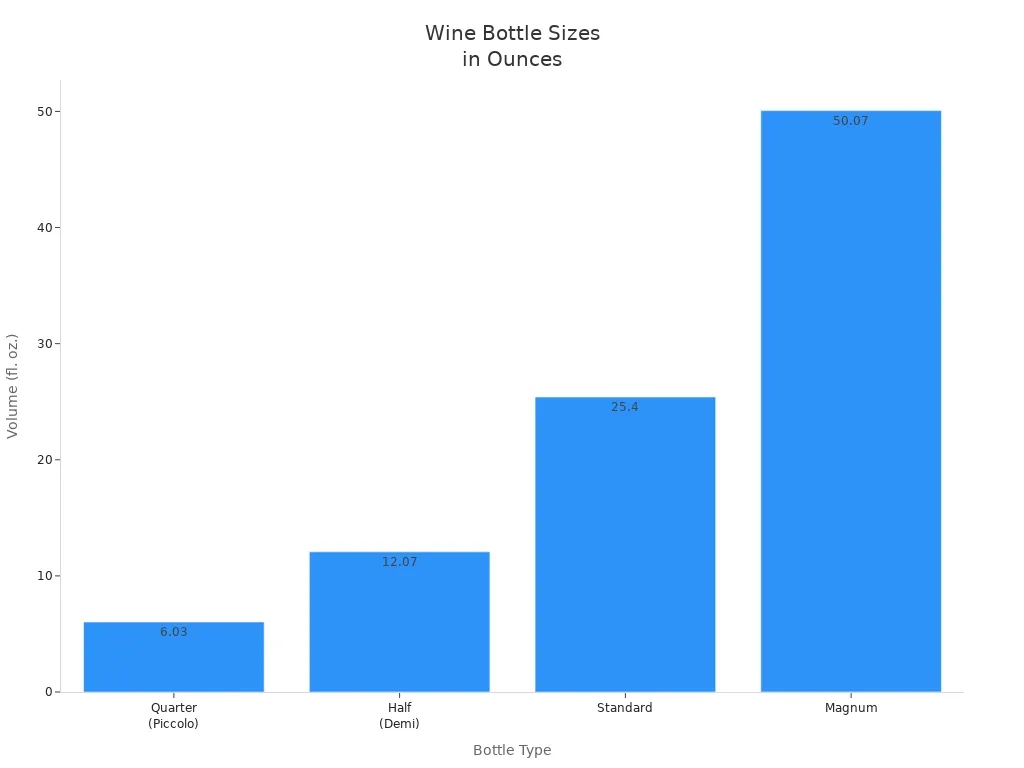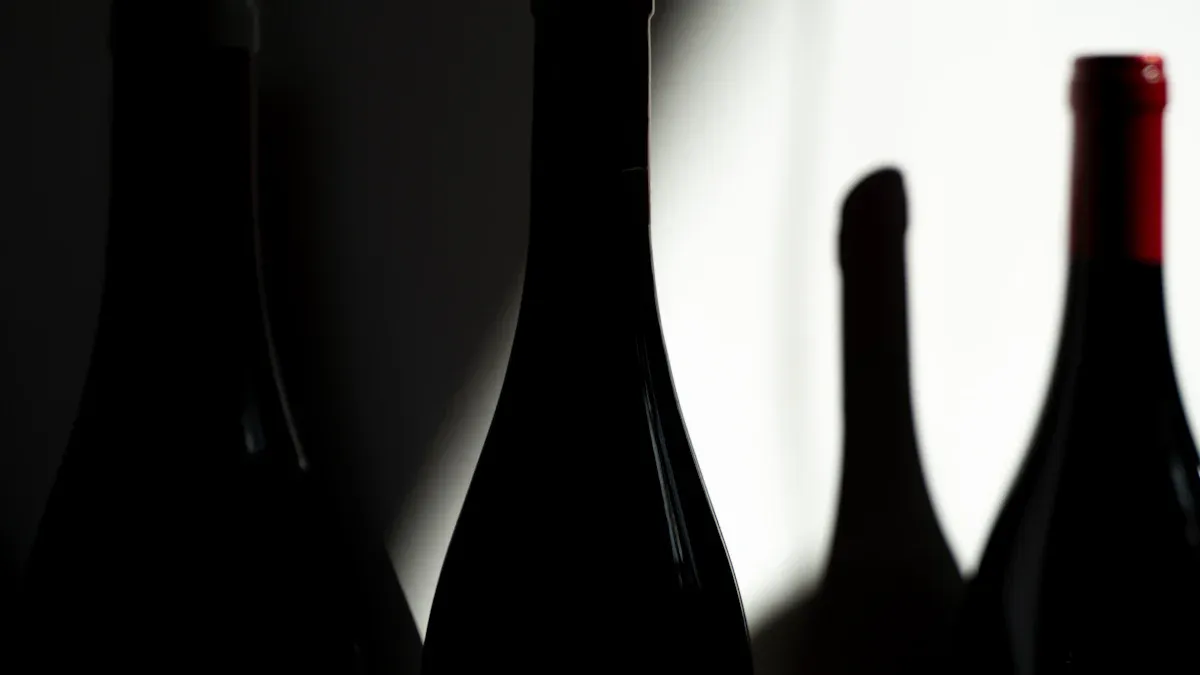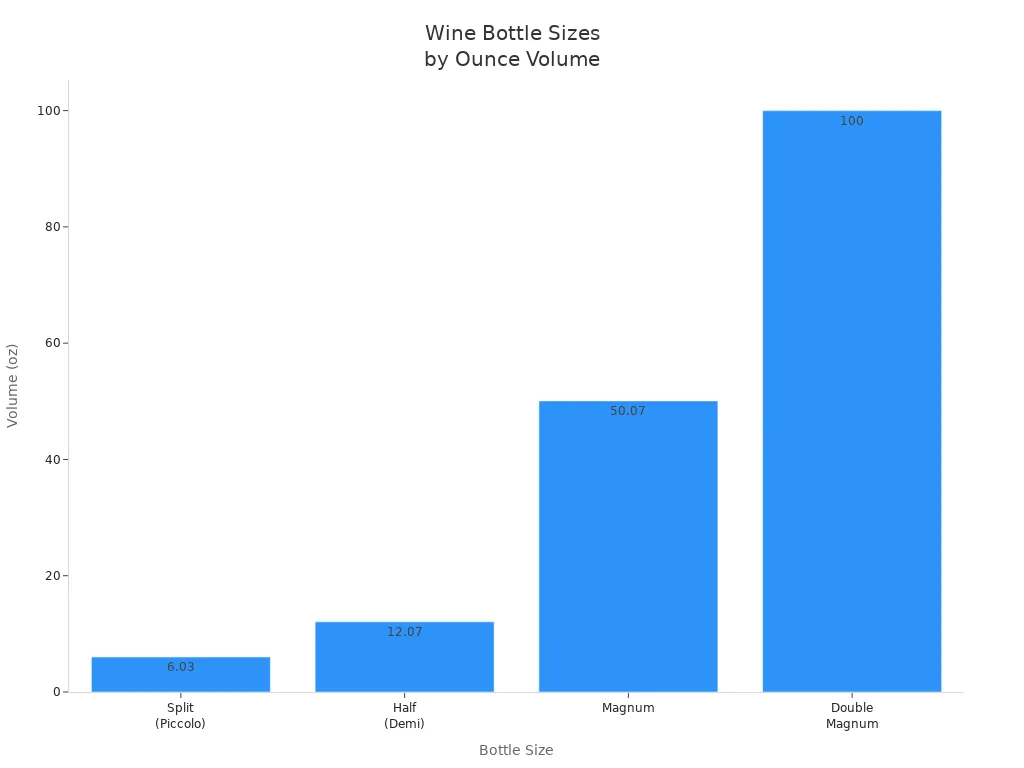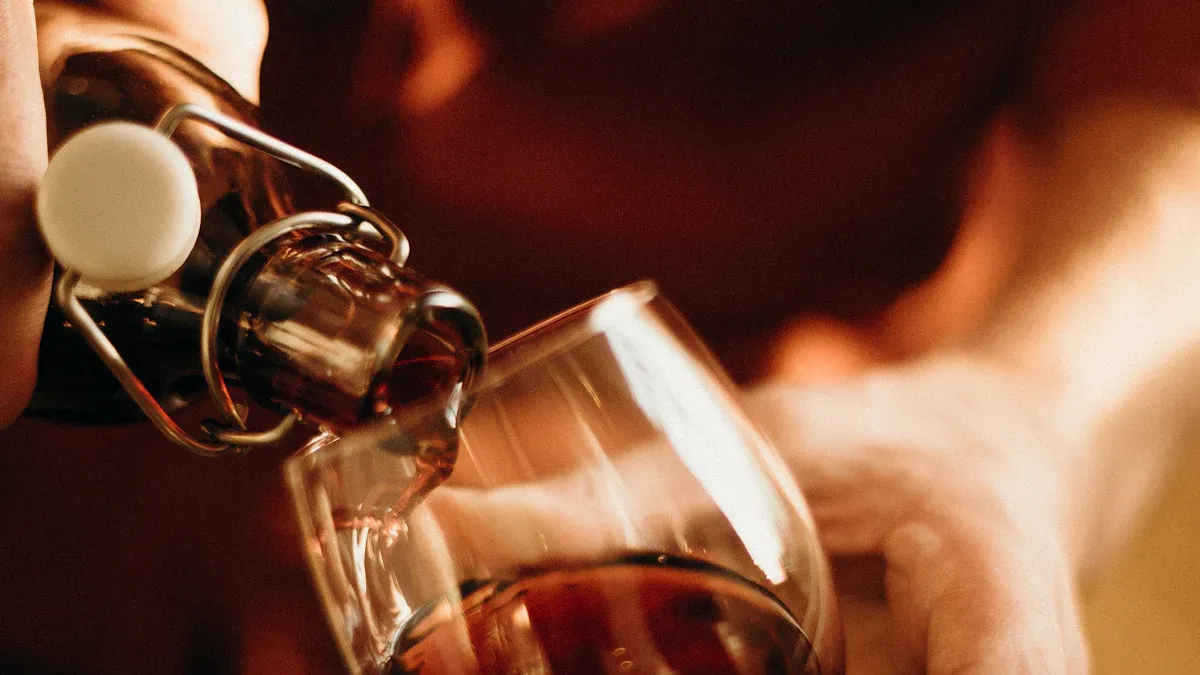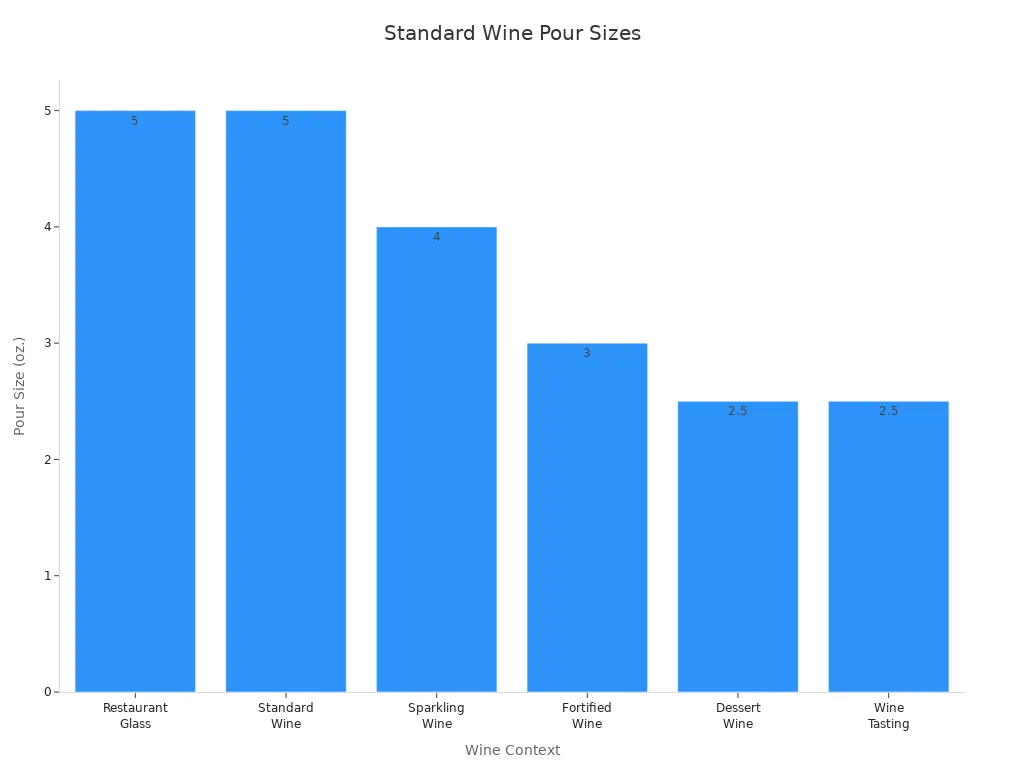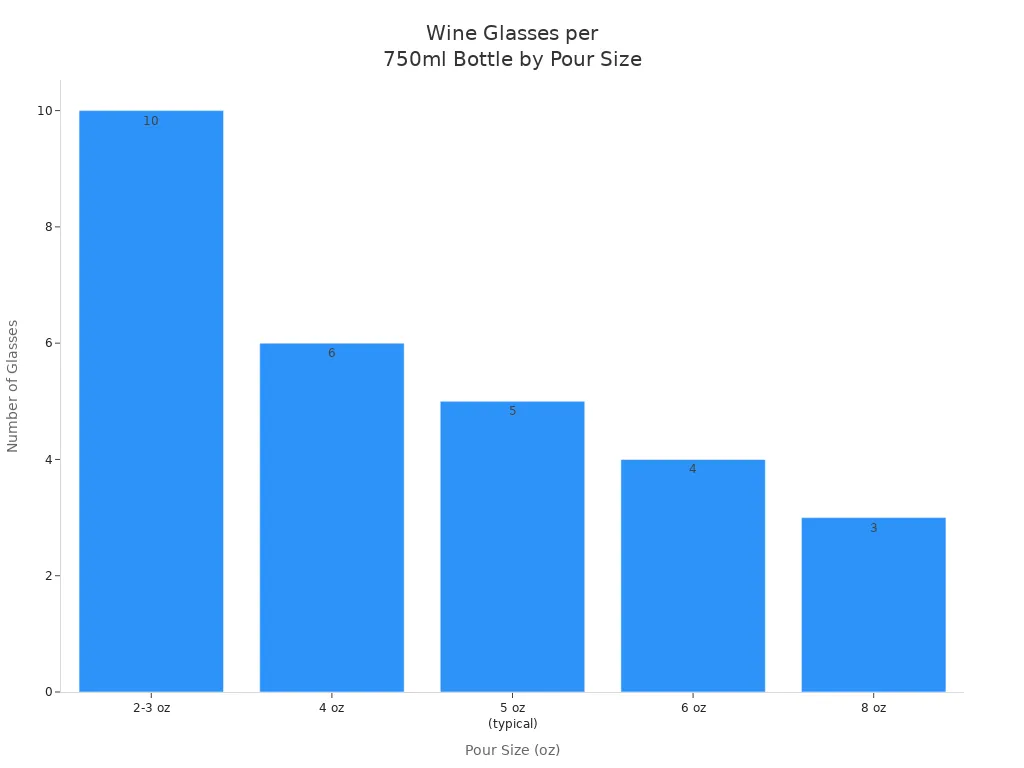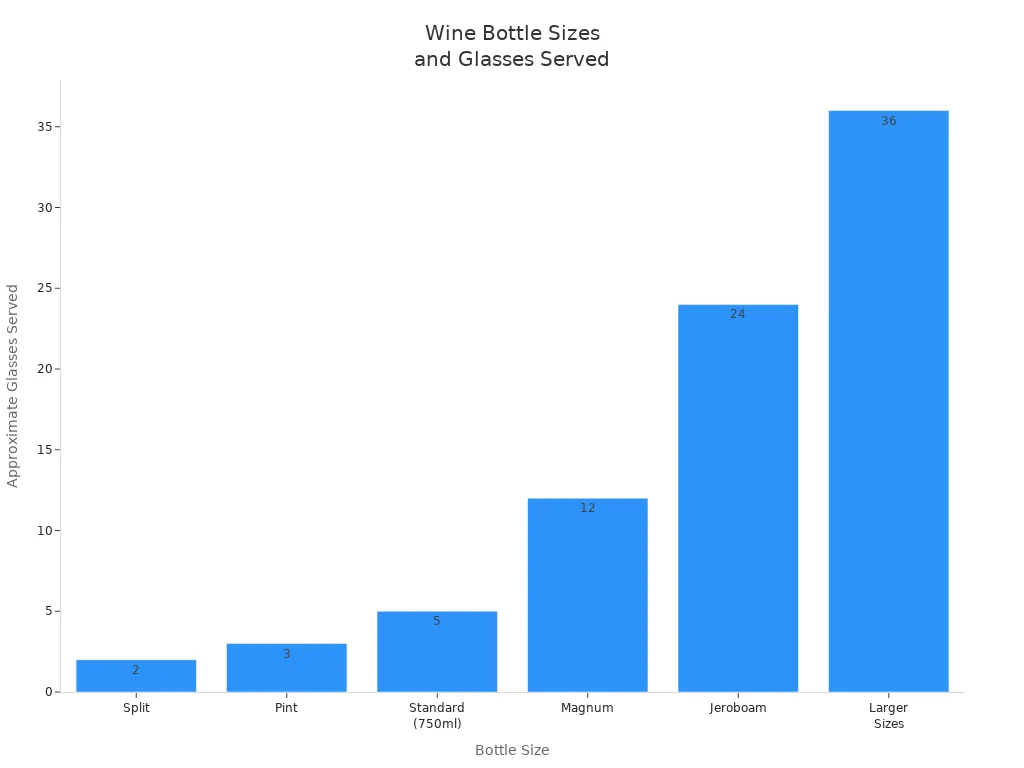
You get 25.4 ounces in a standard bottle of wine. This is the same as 750 milliliters. People all over the world use this as the standard size for a full bottle of wine. This amount stays the same even if the bottle shape is different. The chart below shows how a bottle of wine compares to other common sizes:
![Bar chart comparing ounce capacities of different wine bottle types]()
Wine bottles come in many sizes, so the ounces in each bottle can be different. If you want to know how much wine is in a standard bottle, this guide can help. You can also use it to compare with aluminum cans or other packaging. This quick reference will help you pick the right size for any event.
A standard wine bottle has 25.4 ounces or 750 milliliters. This is the most common size in the world. You can find ounces by dividing the milliliter number by 29.57. This gives you a correct answer. Wine bottles come in many sizes. Small splits have 6 ounces. Big magnums have 50 ounces or even more. A 750ml bottle usually gives about five 5-ounce glasses. The number of servings changes if you pour more or less. The shape of the bottle does not change how many ounces it holds. Always look at the milliliter label to know the exact amount.
Standard Wine Bottle Capacity
Ounces in a Standard Wine Bottle
When you look at a wine bottle, you might ask how much it holds. The answer is easy. A standard wine bottle has 750 milliliters. That is about 25.4 ounces. Most countries use this size for wine bottles. Winemakers call it the gold standard. You will find this size in almost every wine store or restaurant.
The standard wine bottle size has stayed the same for a long time. People trust this size because it gives enough wine for several servings. If you pour a glass, you get about five glasses from one 750ml bottle. Each glass is about 5 ounces. This makes it simple to plan for parties or dinners.
Tip: If you want to compare a wine bottle to other packaging, like aluminum cans or a beer keg, remember that 25.4 ounces is the key number for a standard bottle.
Milliliters to Ounces Conversion
You may see wine measured in milliliters, especially from Europe or Asia. To know how many ounces are in a wine bottle, you need to do a conversion. One US fluid ounce is about 29.57 milliliters. To find out how many ounces are in any wine bottle, divide the milliliter number by 29.57.
Here is a quick reference table for you:
Measurement Type | Milliliters (mL) | Ounces (US fl oz) |
Standard Wine Bottle | 750 | 25.4 |
1 US Fluid Ounce | 29.57 | 1 |
1 Milliliter | 1 | 0.03381 |
If you have a 750ml bottle, you can use this formula:
Ounces = Milliliters ÷ 29.57
So, for a standard wine bottle:
Ounces = 750 ÷ 29.57 ≈ 25.4
This conversion helps you compare wine bottles to other drink containers. You can use it for aluminum cans or even a beer keg. This method works for any wine bottle size. It makes it easy to plan your next event or buy the right amount.
Note: The shape of the wine bottle does not change the amount of ounces it holds. Always use the milliliter number on the label for accurate conversion.
If you want eco-friendly packaging for your wine or other drinks, Hainan Huer Industrial Co., Ltd. has many choices. They offer aluminum cans and custom beverage packaging. Their products help you serve and store your drinks with confidence.
Wine Bottle Sizes
![Wine Bottle Sizes]()
Common Wine Bottle Sizes
When you shop for wine, you see many different bottle sizes. Each size holds a different amount of wine, measured in ounces. You find the standard bottle of wine everywhere, but you also see other sizes in stores and restaurants. Knowing these sizes helps you plan for parties, gifts, or special occasions.
Here are the most common bottle of wine sizes you will encounter:
Split (Piccolo): This small bottle holds about one glass of wine. It is perfect for single servings or tasting events.
Half (Demi): This bottle is half the size of a standard bottle of wine. It works well for solo dinners or when you want to try a new wine without opening a full bottle.
Standard: The standard bottle of wine is the most popular size. You see it in almost every wine shop and restaurant.
Magnum: This large bottle equals two standard bottles. It is great for celebrations or aging wine.
Double Magnum: This size holds four times the wine of a standard bottle. You often see it at big events or in wine collections.
You may also find even larger bottles, such as Jeroboam, Methuselah, and Salmanazar. These are rare and usually used for special occasions or collectors.
Tip: If you want to compare a bottle of wine to other packaging, like aluminum cans or beer kegs, knowing the ounces in each size makes planning easy.
Ounces in Each Wine Bottle Size
You need to know how many ounces are in each bottle of wine to serve the right amount. The table below shows the most popular sizes and their ounce capacity. This helps you understand the variations in wine bottle capacity and choose the best option for your needs.
Bottle Size | Volume (ml) | Ounces (approx.) |
Split (Piccolo) | 187 | 6 |
Half (Demi) | 375 | 12.5 |
Standard | 750 | 25.4 |
Magnum | 1500 | 50 |
Double Magnum | 3000 | 100 |
Jeroboam | 3000/5000 | 100/169 |
Methuselah | 6000 | 203 |
Salmanazar | 9000 | 304 |
![Bar chart comparing ounce volumes of split, half, magnum, and double magnum wine bottles]()
You see that a standard bottle of wine gives you about 25.4 ounces. A magnum holds 50 ounces, which is twice as much. The double magnum jumps to 100 ounces. If you want to serve a crowd, larger bottles save you time and effort.
If you need eco-friendly packaging for your wine or other drinks, Hainan Huer Industrial Co., Ltd. offers a wide range of solutions. You can choose from aluminum cans, beer kegs, and custom beverage packaging to fit any event or business need.
Note: Always check the label for the exact ounces in your bottle of wine. This ensures you serve the right amount every time.
How Many Glasses in a Bottle of Wine
![How Many Glasses in a Bottle of Wine]()
Standard Wine Pour Size
When you order wine at a restaurant or pour a glass at home, you might wonder how much wine goes into each glass. The standard pour of wine in most restaurants is about 5 ounces. This size lets you enjoy the flavors and aromas without overfilling the glass. Wine tastings often use smaller pours, usually around 2.5 ounces, so you can sample more types without drinking too much. Sparkling wines get a 4-ounce pour, while dessert wines are even smaller at about 2.5 to 3 ounces.
Here is a quick table to help you see the typical pour sizes for different types of wine:
Wine Context | Standard Pour Size (oz.) |
Restaurant Glass | 5 to 6 (commonly 5 oz.) |
Standard Wine | 5 |
Sparkling Wine | 4 |
Fortified Wine | 3 |
Dessert Wine | 2.5 |
Wine Tasting | 2.5 (commonly), sometimes 5 |
Napa Wineries Tasting | 1 to 1.5 |
![Bar chart showing standard wine pour sizes in ounces for different contexts]()
Tip: Using the standard pour of wine helps you plan how many glasses you can serve from each bottle of wine.
Calculating Servings per Bottle
A standard bottle of wine holds about 25 ounces. If you use the standard pour of wine, you get about five servings from one bottle. This makes it easy to answer the question: how many glasses in a bottle? The answer is usually five, but the number of servings can change if you use a different pour size.
Here is a table that shows how pour size affects the number of servings:
Pour Size (ounces) | Number of Glasses per 750ml Bottle |
2-3 | 8 to 12 |
4 | 6 |
5 (typical) | 5 |
6 | 4 |
8 | 3 |
If you use larger glasses or pour more ounces, you get fewer servings per bottle of wine. Smaller pours, like those for dessert or sparkling wines, give you more glasses. At home, people sometimes pour 8 to 10 ounces, which means you get only two or three servings from a bottle.
Standard wine glasses are made for a 5-ounce pour.
Larger glasses or generous pours reduce the number of servings.
Smaller pours, like those for tastings or dessert wines, increase the number of servings.
Sparkling wine glasses hold about 4 ounces, so you get six servings per bottle.
![Bar chart showing number of wine glasses per 750ml bottle for different pour sizes]()
If you plan a party or event, knowing the number of servings in each bottle of wine helps you buy the right amount. For larger groups, you might also consider using aluminum cans or beer kegs for easy serving. Hainan Huer Industrial Co., Ltd. offers a full range of beverage packaging solutions, including eco-friendly options for every occasion.
How to Calculate Ounces in a Wine Bottle
Simple Calculation Method
If you want to know how to calculate ounces in a wine bottle, you can follow a few easy steps. This method works for any wine bottle size, whether you have a small split or a large magnum. You only need to know the bottle’s volume in milliliters. Here’s how you do it:
Find the number of milliliters on the wine bottle label.
Remember that 1 US fluid ounce equals 29.5735 milliliters.
Divide the milliliter amount by 29.5735 to get the number of ounces.
If you want to know how many servings you can pour, divide the total ounces by your chosen pour size (like 5 ounces per glass).
Use this formula for any bottle size. Just change the milliliter number.
You can also use a quick formula: multiply the milliliter amount by 0.0338. For example, a 1000 mL bottle gives you about 33.8 ounces. This makes it simple to compare wine bottles to other beverage packaging, such as aluminum cans or beer kegs. If you need help with packaging or want to explore eco-friendly options, Hainan Huer Industrial Co., Ltd. offers a full range of solutions.
Tip: Always check the label for the milliliter amount. This ensures you get the right number of ounces every time.
Why Bottle Shape Doesn’t Change Capacity
You might notice that wine bottles come in many shapes. Some are tall and thin, while others are short and wide. Even though the shapes look different, the number of ounces inside stays the same if the label says the same milliliter amount. The shape does not change the liquid capacity.
Bottle shape can affect how wine ages. Bottles stored on their side keep corks moist, which helps slow down aging.
The shape can make pouring easier or harder. Wider openings let in more air and pour faster, while narrow openings pour slowly and limit air contact.
Darker and thicker bottles protect wine from light, keeping the quality high.
Some shapes help with decanting and controlling sediment, making serving smoother.
Bottle design also helps brands stand out and can influence how you see the wine.
No matter the shape, always use the milliliter label to calculate ounces. This way, you get the right amount for every event or meal. If you want to package your wine or other drinks in unique shapes, Hainan Huer Industrial Co., Ltd. can help with custom aluminum cans and other beverage packaging solutions.
You now know a full bottle of wine holds about 25 ounces, and larger bottles serve more guests. Use the table below to quickly compare wine bottle sizes and glasses served:
Bottle Size | Ounces | Glasses Served |
Standard | 25 | 5 |
Magnum | 50 | 10 |
Jeroboam | 101 | 20 |
![Wine bottle sizes and glasses served]()
Choose the right bottle for your event, and consider aluminum cans or a beer keg for easy serving. Plan ahead so every guest enjoys their wine.
FAQ
How many ounces are in a standard bottle of wine?
You get 25.4 ounces in a standard wine bottle. This equals 750 milliliters. Most wine shops and restaurants use this size. You can plan servings easily with this number.
Can wine bottles come in different sizes?
Yes, wine bottles come in many sizes. You find split bottles with 6 ounces, magnums with 50 ounces, and even larger bottles. Always check the label for the exact ounce count.
How many glasses can you pour from one bottle of wine?
You usually pour five glasses from a standard bottle. Each glass holds about 5 ounces. If you use smaller pours, you get more servings. Larger pours mean fewer glasses.
Does the shape of the wine bottle change how many ounces it holds?
No, the shape does not change the liquid capacity. You should look at the milliliter label to know the exact ounces. The design only affects how the wine pours or ages.
Where can you find eco-friendly wine packaging options?
You can find eco-friendly wine packaging at Hainan Huer Industrial Co., Ltd. They offer aluminum cans, beer kegs, and custom beverage packaging. These options help you serve wine and other drinks while supporting sustainability.


















